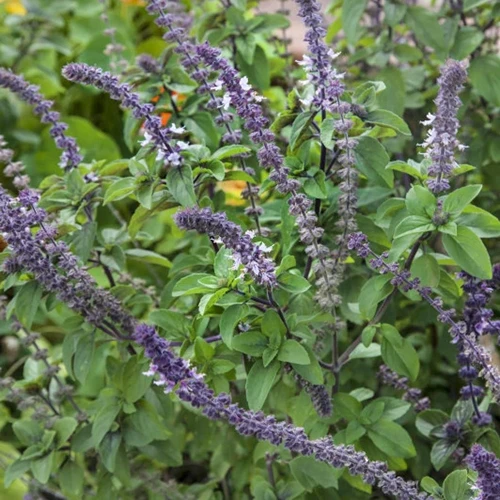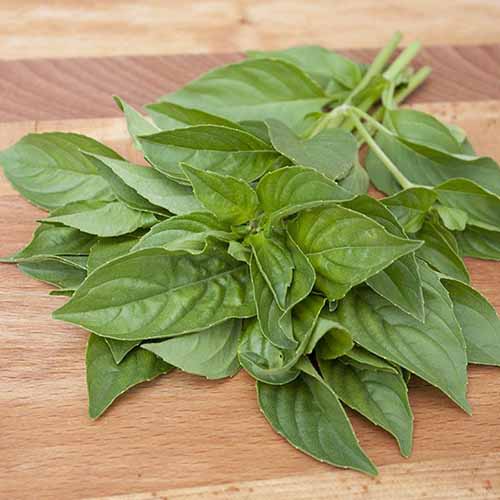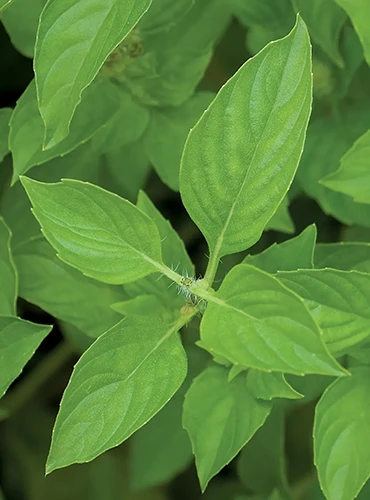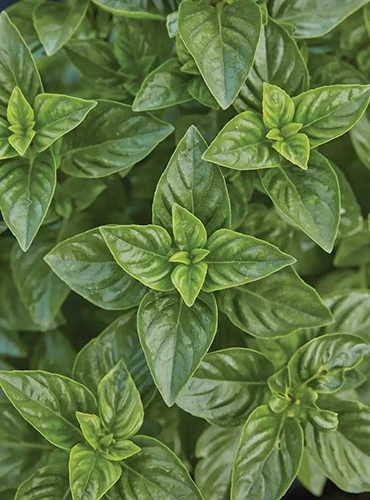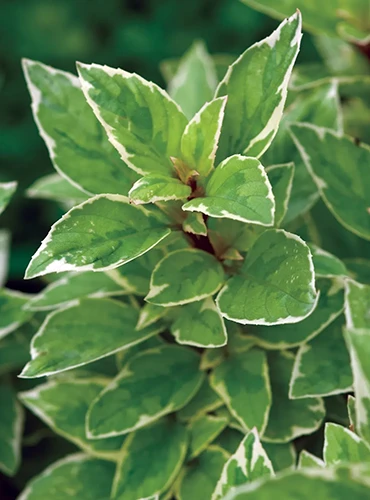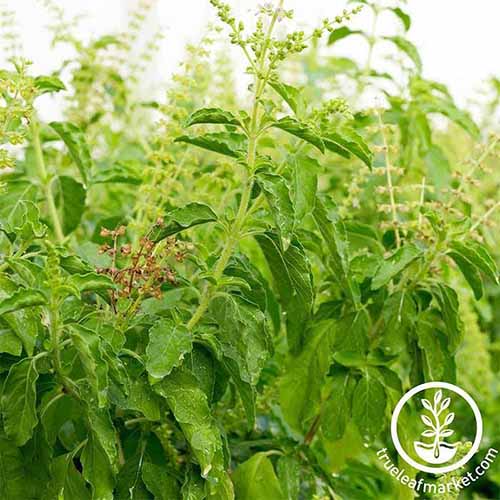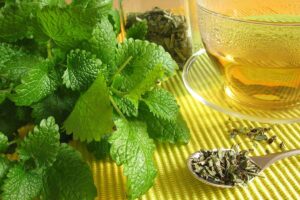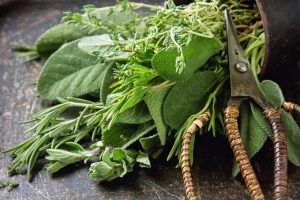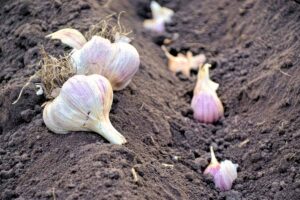If you’re always looking for kitchen shortcuts, here’s one that starts in the garden.
I’m speaking of a group of herbs known as citrus basils. These plants have leaves with the typical herbal, anise-like flavor that characterizes basil plants, along with an added zing of citrus.
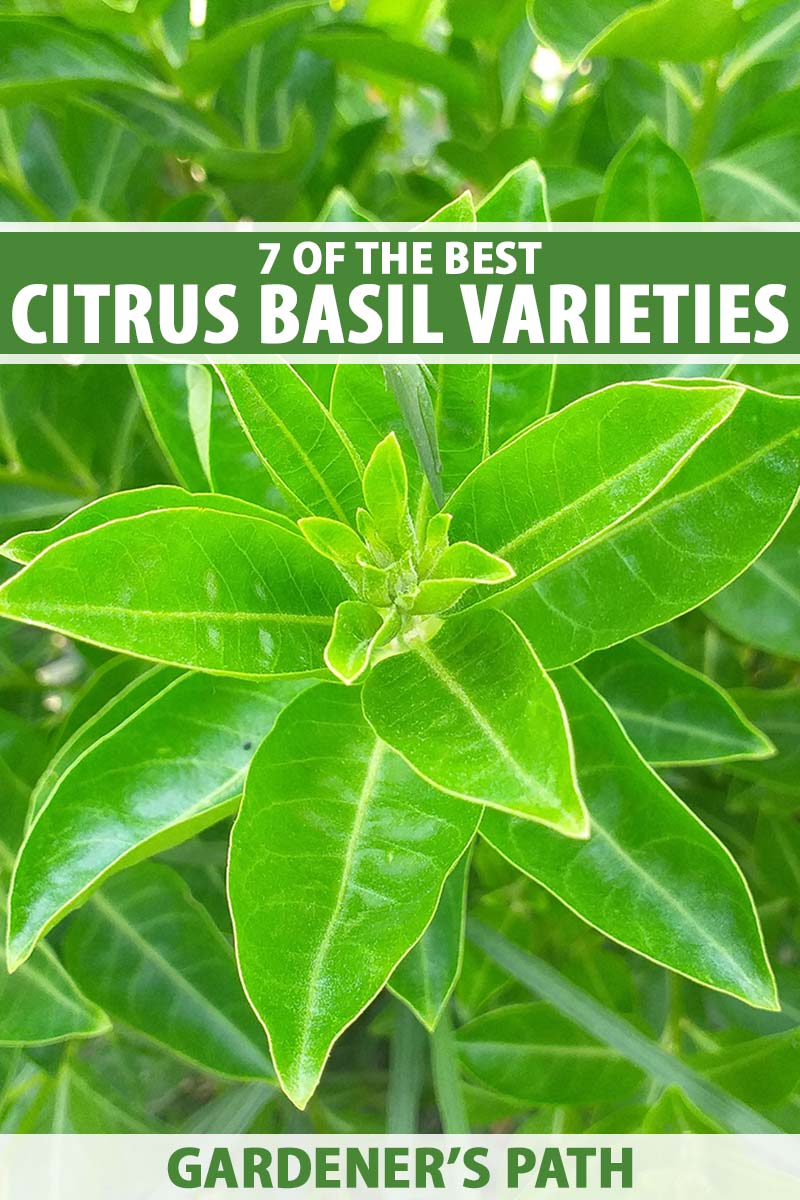
We link to vendors to help you find relevant products. If you buy from one of our links, we may earn a commission.
The flavor combo comes in handy when you’re adding fresh, homegrown herbs to dishes as varied as sorbet or a lemony orzo salad.
And the joy of growing these varieties extends beyond the culinary. Each also has aromatic and edible flowers – if you’re willing to sacrifice the flavor of the leaves by letting the plants bloom in late summer.
These scents are also citrusy to various degrees, and the aroma attracts pollinators and delights humans who are within range on a fine summer day.
Even if you’re the sort who never gets around to cooking the herbs you grow, you can enjoy the simple pleasure of crushing a leaf or bloom between your fingers to release the heady lemon or lime perfume.
You may be surprised to learn that all the varieties I’ll share here are relatively easy to grow in a raised bed, container, or even indoors on a sunny windowsill.
The size and bloom colors of the herbs in this category can vary quite a bit, but all have similar growing requirements.
They’re hardy in USDA Zones 9 to 11 if you wish to keep them going outdoors year-round as perennials, but they may be grown as summer annuals in any Zone.
Citrus basil thrives in full sun and well-draining soil that’s rich in organic matter. And deer will leave these plants alone.
You can learn more about citrus basil in our growing guide.
Ready to pick a favorite and start propagating?
Whether for its culinary uses or based on its growing habit, I know you’re sure to find a favorite or two among the picks on our list! Let’s go ahead and start the introductions.
7 of the Best Varieties of Citrus Basil
1. Blue Spice
A tangy citrus flavor gives you a boost, not the blues, but this distinctive upright basil, a hybrid cross of O. americanum and O. basilicum, has deep blue blooms that inspired its name.
Its velvety leaves have a flavor base of spicy anise with accents of both vanilla and lemon. They are tasty added to fruit sorbets and poultry marinades or minced fine and tossed with fruit salad.
You can also dry the leaves for potpourri or use stems or flower stalks in bouquets and arrangements.
The plants grow about 12 to 18 inches tall and about a foot wide, which is an appealing size for containers and window boxes. This variety is also more resistant to downy mildew than other basils.
If you plan to grow it more for the scent and ornamental value than the flavor of its leaves, make sure to place ‘Blue Spice’ near a patio, walkway, or outdoor kitchen so everyone can enjoy the aroma.
The fragrance is truly delightful. Maybe we should start calling this “Banish the Blues Spice basil” instead?
‘Blue Spice’ seeds are available in packets and in bulk from Eden Brothers.
2. Lemon
Would you like some lemon with that?
Most lemon basil seeds and plants available to home gardeners are simply labeled “lemon basil.”

You may see them classified as O. x citriodorum or O. basilicum.
Light green lemon basil stems sprout leaves that are smaller and more pointed than most sweet types you may already cook with.
They are popular in Indonesian cuisine and make a lemony complement to grilled fish or tuna salad. Or you can use them in place of sweet basil in most sauces, marinades, or confections.
The most distinctive trait of lemon basil is its high citral content.
This essential oil has an aroma much like a lighter, brighter lemon balm and it’s often used to infuse soaps, lotions, and lip balms with lemony goodness.
The leaves are also suitable for drying to use in tea and potpourri.
Expect a mature height of 12 to 24 inches, with stalks of white blooms in late summer.
Open-pollinated seeds are available from High Mowing Organics.
3. Lime
Lime basil, O. americanum, is zesty but more subtle in flavor than its lemony relatives.
It is often called hoary basil with reference to the fine hairs that grow inside the calyces that hold its blooms.
Lime plants tend to be smaller than most O. basilicum types. They attain about a foot in height and spread just 10 inches or so.
Their lime scent is pervasive but pleasant, emitting from the stems, leaves, and clusters of dainty white or purple flowers.
You could simply sniff the aroma from the comfort of an Adirondack chair or a blanket spread on the lawn and go no further, but if you want to use lime basil for cooking or decorating, there are dozens of options available to you.
Macerated, the herb can replace lime zest or peel in simple syrup for limeade or cocktails like mojitos, for example. Dried, its essential oils complement many potpourri combinations.
Minced, it flavors cookies and sorbets or peps up sauces, salsa, or Caprese salads.
Remember that while it’s not as intense as lemon basil, the flavor is stronger than that of most sweet varieties, so adjust proportions accordingly in cooking.
Seeds are available from Burpee and Eden Brothers.
4. Limoncello
Maybe it’s time to expand upon basil’s reputation as an indispensable ingredient in savory Italian dishes and sauces.
Though this herb originated in India, Iran, and other parts of Asia, only reaching Italy and other parts of western Europe in the 1500s, it’s now considered synonymous with Italian flavor, especially in pizza and tomato sauce, not to mention pesto.
But it’s never been associated with the citrusy Italian liqueur known as limoncello… until now.
‘Limoncello’ would be a natural ingredient in many of the same dishes and drinks where home cooks and mixologists use limoncello, in fact.
The leaves could be simmered into a simple syrup for icy adult lemonades, for example, or macerated in spirits to add to Italian cakes or ice cream.
Or, you could enjoy the limoncello essence alcohol-free, using a chiffonade of fine shreds to garnish desserts or enliven fruit salad.
This extra-prolific variety matures quickly, reaching about 16 to 17 inches in height and spreading 12 to 13 inches in just 25 days, which is at least a couple of weeks faster than similar varieties.
Its leaves are bright green and almost heart-shaped. They have a ribbed texture that makes them extra appealing in bouquets or for use as garnishes.
‘Limoncello’ is available in 50-seed packets or as part of a mix-and-match set of three live plants from Burpee.
5. Mrs. Burns’ Lemon
Skip the burn and feel the zing with this tangy, open-pollinated cultivar.
This basil has the traditional anise flavor of popular sweet varieties infused with sweet lemon essence.
It looks much like the typical basil plant you would score at the grocery store, too, with two-and-a-half-inch-long leaves of bright, tender green.
‘Mrs. Burns’ Lemon’ is handy in the kitchen for flavoring salads, dressings, and sauces, but use it more sparingly than other sweet basils since even its light lemon taste can overwhelm more delicate flavors.
As a fresh garnish or used in herb butter, this cultivar sings on grilled fish or seafood stews.
The plants take about 60 days to reach their full size of 20 to 24 inches tall and 12 to 24 inches across.

If you’re a devoted seed saver, consider ‘Mrs. Burns’ Lemon,’ since the seeds that follow the white, late-summer blooms will grow true with the same characteristics as the parent plant.
Find ‘Mrs. Burns’ Lemon’ in 100-seed packets from Park Seed via Amazon.
6. Pesto Perpetuo
Claiming this citrus basil cultivar will provide pesto ingredients into perpetuity involves a bit of poetic license, but it does come pretty dang close.
It’s a shrubby variegated plant with white-edged leaves, the naturally-occurring sport of Ocimum × citriodorum ‘Lesbos,’ a variety of Greek columnar basil.
It grows upright and takes from 30 to 60 days to attain about three feet in height and spreads about two feet. The overall effect is almost like a topiary, but that’s not the most amazing thing about ‘Pesto Perpetuo.’
Its claim to fame is its non-flowering growth habit. As you might recall, when basil blooms, the leaves tend to lose their flavor.
This patented variety doesn’t have that issue so you can harvest the foliage for pesto, sauces, marinades, and garnishes almost into perpetuity. Or until winter rolls around…
‘Pesto Perpetuo’ is available as part of a “mix and match” set of three live plants from Burpee.
7. Sweet Dani
Watch out, Neil Diamond! Ocimum × citriodorum ‘Sweet Dani’ can also make you swear the good times never seemed so good – or perhaps more precisely, good foods never seemed so lemony without using citrus fruits.
This is a small-leaf variety with extra citral for lots of lemon flavor.
Growing about 26 inches tall and reaching out to 12 inches, it’s an ideal size for containers.
This cultivar was a hit when it was first introduced in the 1980s, thanks to both its heightened essential oil content and its extra disease resistance. It has been growing strong ever since, winning All-America Selection honors in 1998.
Consider planting it in a pollinator garden – the small white flowers attract bees and other flying pollinators. Or, you can pinch it back several times over the season to discourage blooming and make the plant bushier.
Plan to use the copious harvest fresh in lemon cookies, sorbet, and the like, or for grilling marinades or lemon chicken stir fry.
The leaves dry readily and hold their lemon scent in potpourri, sachets, and scented homemade soaps or lotions.
‘Sweet Dani’ is available in 100-, 1,000- and 5,000-seed packets from True Leaf Market.
Get the scoop on growing and caring for ‘Sweet Dani’ in our guide.
The Sweet-Tarts of the Herb Garden
I have one more nice thing to say, and it applies to all of these recommended varieties:
Basil is such a valuable herb that’s easy to grow to flavor homemade cuisine. But it is just as valuable to pollinators if you allow it to flower!
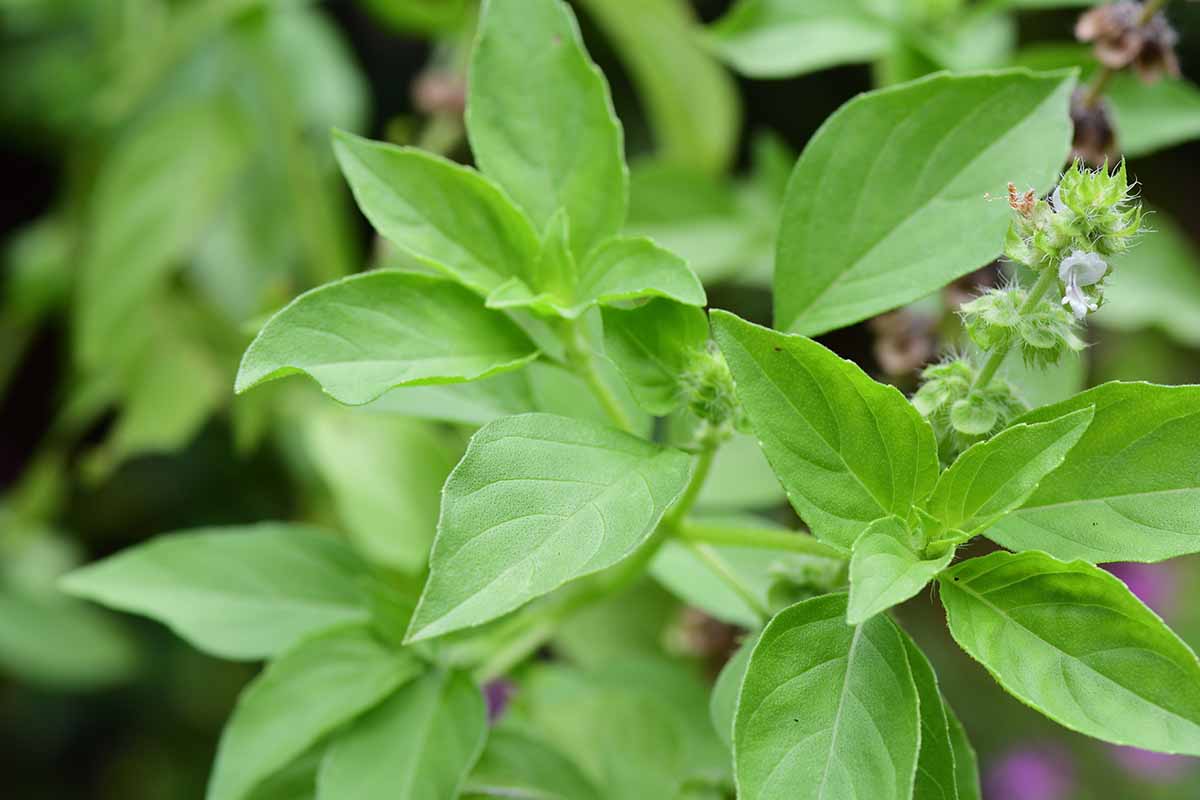
And at season’s end, any plants you didn’t pick or that froze can go into the compost to build soil for next year. Show me a bottled salad dressing that can do that!
Do you have any citrus basil praise, criticism, or questions? Be sure to add your input in the comments section below.
And if you’re up for learning more about growing and caring for basil, check out these guides next:
